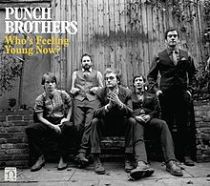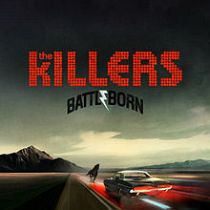Soon, we will get to the albums. But first, the rules:
1. The albums had to be released during the calendar year of 2011.
2. The albums had to be full-length albums of new material.
3. The albums couldn’t be live albums that consisted primarily of live versions of previously released material from the artist.
#10. Fun., Some Nights
Some Nights is just a, well, Fun album. It opens with an operatic intro to the title track, “Some Nights” that is very reminiscent of Queen. From there, the band goes into “Some Nights” proper, which itself begins a capella. Throughout the album, Fun mixes modern pop/rock instrumentation with a new twist here and there, such as the operatic intro to “Some Nights”. The drums and percussion in the first few songs are especially catchy and fit well with the rest of the songs. Lyrically, the album is relateable. “If you’re lost and alone or you’re sinking like a stone, carry on. May the past be the sound of your feet upon the ground, carry on.” While Some Nights may not break much new ground, it is still a solid album that is one of the best of the year, simply for how Fun it is.
#9. Punch Brothers, Who’s Feeling Young Now?
With Who’s Feeling Young Now?, Punch Brothers continue in the same direction as their first two albums. With this album, Punch Brothers have created a firm identity and sound in their blend of bluegrass and rock. Although the band is a normal 5-piece band including mandolin, fiddle, banjo, guitar and bass, this isn’t your granddaddy’s bluegrass mandolin. Chris Thile’s vocals and mandolin are the centerpiece of the album, but his playing seems as influenced by rock as it is pop, which gives the band a very unique sound. You can tell as you’re listening to the album that the band is having the time of their lives. Punch Brothers also has a way with words. On the song “This girl”, Thile “prays” to God, saying, “There’s this girl…and I’d be the happiest backslider in the world if You would tell her that it’s Your will for us to be…” Or take this line from “City Girls”: “City girls are all the same, they play you like a pinball game, Oh what a summer!” One can tell just from this line that there’s a whole backstory to this character that we want to know. If you’re up for a unique sound that derives from bluegrass and rock, Punch Brothers is the band for you.
#8. The Killers, Battle Born
Battle Born is the first album from The Killers in four years, and their return is worth your listen. The time away served the music well. Battle Born is a solid rock album. Brandon Flowers’ voice is on the high side, and at times the mix of his voice and the big, full sound of the music reminds one of Bono and U2. The music is such that after a couple listens, you will be singing along with the songs. The lyrics and music just fit together. They’re simply right. The words fit the music, and vice versa. Lyrically, The Killers are singing about places, feelings and situations that are universal. In “The Way It Was”, the speaker is sizing up a fading relationship, with the honest question, “If I go on with you by my side, can it be the way it was?” In “Here With Me”, the speaker, who is in a long distance relationship, tells his significant other, “Don’t want your pictures on my cell phone—I want you here with me. Don’t want your memory in my head, no, I want you here with me.” This is a great album to turn up loud, sing along with, and enjoy.
#7. Propaganda, Excellent
While I am not a huge hip-hop/rap fan, I simply could not ignore Excellent by Propaganda. This album is simply a work of art. The music is good, strong, straightforward hip-hop, but the lyrics are what shine on this album. Propaganda introduces himself in the first song by presenting himself as a “fire baptized battle rapper, who’s heavily influenced by folk music. I found creative freedom in poetry…I’m the son of a black panther, with a Mexican spouse and Caucasian best friends. And my writing tone, now, is not one that offers you a neat little bow to tie all your problems up with…I have a degree in illustration and intercultural studies, and a teaching credential, yet I rap for a living. Let that sink in.” Propaganda isn’t afraid to be confrontational when need be, or to address important topics in a real way. In “Don’t Listen To Me”, with regards to the pyramids and other ancient wonders, he says, “I know academia is so drunk on arrogance and racism that they’d rather credit these accomplishments to aliens than to admit that we are not the smartest civilization to ever live.” In “Precious Puritans”, he encourages Pastors to think about what it sounds like to minorities when they quote Puritan Christians to minorities, even though those Puritan Christians had slaves. Instead of just letting it sit there, though, he turns the whole song on its head by the end, when he challenges minorities to understand that they are no less fallen than the Puritans. None of us are perfect and we all have our blind spots, leading Propaganda to the conclusion that “God really does use crooked sticks to make straight lines”, crooked sticks such as the “Precious Puritans” and himself. Propaganda’s Excellent was by far the biggest surprise for me this year. You don’t want to miss this one!
#6. Mumford & Sons, Babel
If you liked Sigh No More, then you will love Babel. With their newest album, Mumford & Sons develop their unique sound. While Babel is similar musically to Sigh No More, their sound is so unique when compared other bands that the similarity between this album and the last is not a bad thing. Musically, the band continues to combine rock guitars and percussion with bluegrass and folk instrumentation. The banjo carries a number of the songs, yet the vocals keep the band firmly planted in folk-rock rather than bluegrass. Speaking of the vocals, as would be expected from Sigh No More, the harmonizations on songs like “Hopeless Wanderer”, “Broken Crown” and “Below My Feet” are simply outstanding. Mumford also likes to experiment with dynamics of volume, often starting with a single voice, then swelling to louder instruments and harmonizations in the chorus. Lyrically, the band continues in with sometimes abstract lyrics, with religious references sprinkled throughout. Still, there are a number of great one-liners sprinkled throughout the album, like “I will love with urgency but not with haste…” from “Not With Haste”. If you get the album, it is well worth spending the extra money for the deluxe edition, which includes a cover of Paul Simon’s “The Boxer”, on which Paul Simon and Jerry Douglas both play.
#5. Charlie Peacock, No Man’s Land
Charlie Peacock is perhaps one of the most talented producers/artists/musicians in the world. Along with his own music, he has discovered acts like Switchfoot and The Civil Wars. On No Man’s Land, though, Peacock shows us that years away from solo vocal recording has not hurt him at all. While Peacock has normally planted his own records in the pop/rock genre, maybe the best way to describe the music on No Man’s Land is to call it Cajun Americana Folk. “Mystic” speaks of going to Louisiana, and that is exactly where this music makes you feel you are. The studio musicians that Peacock enlisted to join him are top of the line musicians including Steve Brewster, Mark Hill, Jerry McPherson, Sam Ashworth, Bruce Bouton, Jeff Taylor and Andy Leftwich, along with Jeff Coffin from the Dave Matthews Band. Thematically, No Man’s Land includes a good combination of more abstract lyrics and pretty straightforward lyrics. The opener, “Death Trap”, says “If a man can’t hold his tongue ‘til the anger is done, he’ll be walking right into a death trap.” On the more ambiguous side is the 6 and a half minute song “Kite In A Tree”, which ends with the lyric “If belief is only a construct, my own little thumbsuck, then I’m a kite in a tree.” While not impossible to interpret, this one does take a little more thinking than “Death Trap”. I won’t spell it out for you, though; I’ll let you figure it out on your own—that is clearly what Peacock intended. No Man’s Land is a welcome return to solo work for Charlie Peacock, although he’s not really gone anywhere in the intervening years—he’s just been more of a behind-the-scenes guy, propelling other artists forward. We can only hope it won’t be another 12 years until his next solo album.
#4. David Crowder Band, Give Us Rest
David Crowder Band once again shows us that they are a group of artists the likes of which worship music has never seen, and is rare in any genre of music. Give Us Rest is the last offering from David Crowder Band, and knowing that from the beginning allowed the band to creatively address that fact in every aspect of the album. Structurally and thematically, the 2-cd set is arranged in the form of a Requiem Mass, which is a traditional funeral mass. One can follow the album while looking at the structure of a Requiem Mass and it fits perfectly. Yet, if one is unfamiliar with the Mass, it is not distracting at all. Staying within the structure makes David Crowder Band even more creative than they already are, almost working like a Sonnet, where there is a set meter, and the talented author shines even more because of the limitations. Musically and lyrically, David Crowder Band is at its best, offering solid worship, seen through the lens of death, rest and resurrection. The set ends with a few acoustic songs, the last of which is an acoustic version of “Because He Lives”. What a fitting way to end the career of the band (at least as its been known), as well as ending an album about death and resurrection—it is all only possible because He lives.
#3. Derek Webb, Ctrl, SOLA-MI, The Nexus
No, I don’t allow ties in the Top Ten. These two albums are taken together because Derek Webb is behind them both, and because they fit together musically and thematically, telling one big story. I’m only going to write a few lines about it, because Webb intended the whole project as a big puzzle. Suffice it to say that these albums fit together, along with a short story Webb wrote ahead of time to guide him in the project. Thematically, the story struggles with issues of technology, control and our daily lives. Webb is the master artist—when he is dealing with the more human side of things the music is very acoustic and “real”. When he is dealing with the more technological side of things, the music is more electronic, or “fake” if you will. I don’t want to say too much more than I already have about the project—I would just encourage you to get these albums. They will make you think about ethics and technology in ways that you never have before.
#2. Andrew Osenga, Leonard the Lonely Astronaut
Andrew Osenga’s newest is a concept album that tells the story of Leonard. Leonard is in the middle of a divorce when his soon-to-be ex-wife dies. Because of this, Leonard decides to take part in a solo space flight. Because of the relativity of time, when Leonard gets back to earth, everyone he knew will be dead. The album chronicles Leonard’s time on the journey, and the emotions Leonard experiences. Musically, Osenga’s signature electric guitar shines. The music is basically electric guitar rock, though there are some more jazzy elements on a couple of instrumentals. Whether it was purposeful or whether Osenga was simply trying to capture the human experience, one can almost trace the 5 stages of grief as Leonard experiences them. The real surprise is that while the story of Leonard is very specific—a divorcee loses his wife and then becomes an astronaut—it is immensely relateable, because we all have lost something. We all have experienced grief. It is this human experience that Osenga taps into that makes this very specific story immensely relateable. This album will take you on an emotional journey that you haven’t experienced in a long, long time. This is storytelling at its best.
#1. Andrew Peterson, Light For The Lost Boy
While Osenga’s Leonard the Lonely Astronaut explores loss on an individual level, Light For The Lost Boy tells the story of universal loss—the loss of innocence. When Peterson talks about the writing of this album, he recognized that as he was writing, this image of a boy lost in the woods keep creeping into different songs. At the center of the album is “The Ballad of Jody Baxter”, a song inspired by the book The Yearling, which itself uses the relationship between the boy and a deer in the woods, and (SPOILERS) the deer’s eventual death, to tell the story of a loss of innocence. Peterson sings of the fact that things aren’t the way they should be, from the personal level all the way through the natural world. On “Come Back Soon”, Peterson sings “If nature is red in tooth and in claw, then it seems to me that she’s an outlaw. ‘Cause every death is a question mark at the end of the book of a beating heart, and the answer is scrawled in the silent dark on the dome of the sky in a billion stars. But we cannot read these angel tongues and we cannot sing with these broken lungs, so we kick in the womb and we beg to be born—Deliverance! Deliverance O Lord!” While Peterson sings of the pain and loss, though, he also sings of the hope we have a Christians. On “Day By Day”, he sings, “So don’t lose heart, though your body’s wasting away. Your soul is not, it’s being remade. Don’t lose heart. Don’t lose heart—your body will rise and never decay, day by day by day!” Though Peterson begins by singing about the loss we all experience, he ends by being so hopeful in the face of loss that the only response is to thank Someone. “Well have you ever wondered why, in spite of all that’s wrong here, there’s still so much that goes so right, and beauty abounds? ‘Cause sometimes when you walk outside the air is full of song here, the thunder rolls and the baby sighs, and the rain comes down. When you see the spring has come and it warms you like a mother’s kiss, don’t you wanna thank Someone? Don’t you wanna thank Someone for this?”
Light For The Lost Boy is the most hopeful and joyous album I’ve found in a while. But it’s not hopeful at the expense of acknowledging the reality of evil. It’s hopeful because we know Who writes the Story. It’s hopeful because we know who the Author is. If you only get one album this year, make it this album. And then do yourself a favor and get the rest of Peterson’s albums as well. You won’t regret it!









